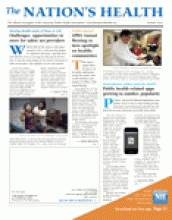Climate change
The Natural Resources Defense Council in August released an online tool to show how each state is impacted by climate change. Climate Change Threatens Health provides local and national maps of extreme weather patterns, details local climate change vulnerabilities and teaches the health implications of climate change in communities. The tool is available at www.nrdc.org.
Malnutrition
The World Health Organization in August released new Web-based guidelines to help governments and health care providers combat malnutrition. Online at www.who.int/elena, the WHO e-Library of Evidence for Nutrition Actions contains information on undernutrition, or insufficient food intake, as well as obesity and vitamin and mineral deficiencies.
Choking
The American Academy of Pediatrics and the American Academy of Otolaryngology-Head and Neck Surgery in August launched a joint Choking Hazards Campaign. Designed to inform parents and caregivers of young children about choking, the campaign includes prevention tips, social media platforms and links to parenting advice. Campaign materials are available at www.entnet.org/HealthInformation.
Oral health
The National Maternal and Child Oral Health Resource Center in June released two new resources on providing oral health care for children with special needs. “Oral Health Services for Children and Adolescents With Special Health Care Needs: A Resource Guide” provides journal articles and resource materials. “Resource Highlights: Focus on Children With Special Health Care Needs” provides a short list of websites and materials on the topic. Both are available at www.mcoralhealth.org.
Information technology
The Office of the National Coordinator for Health Information Technology in June released a set of 20 curriculum components for higher education courses in health information technology. Each component includes several lesson units, including slide-based lectures, learning activities, self-assessment questions and instructor manuals. All material can be downloaded at no cost at www.onc-ntdc.org.
Preventive screening
Omnigraphics in July released a new addition to its health reference series. “Medical Tests Sourcebook: 4th Edition” provides updated information on screening, diagnostic and disease-monitoring procedures. For more information or to order a copy, visit www.omnigraphics.com.
Food emergencies
The Food and Drug Administration in July released a Web-based collection of scenarios that will help government agencies, public health organizations and the food industry test their readiness for food-related emergencies. The tool — the Food-Related Emergency Boxed Set — consists of five scenarios and can be accessed at www.fda.gov/food.
- Copyright The Nation’s Health, American Public Health Association









